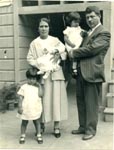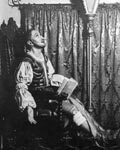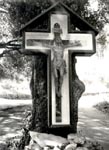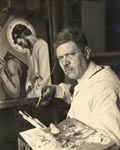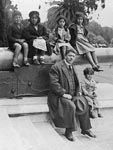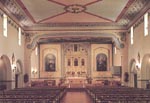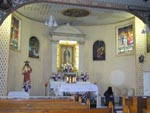The Heinsbergen Murals
Anthony B. Heinsbergen (1894-1981) was perhaps America's greatest interior designer of the famed American Palace Theaters. A highly educated art student, he completed his apprenticeship first in his native Holland, and then in California. A remarkable muralist himself, he established the Heinsbergen Decorating Company in 1922, and went on to hire over a hundred artists to capture the most prestigious fine art commissions of the day, especially on the west coast. In 1928, he hired Candelario Rivas as one of his principal artists and lead formen. Candelario brought a rare, unstylized classical approach to the studio that was no longer taught in the major art schools in Europe nor in the Americas. In an interview with Anthony Heinsbergen Jr. in 2002, he disclosed to the author that his father highly respected Candelario. Of all the artists working for him, he only addressed Candelario Rivas as "Mister," and he was the only artist that he invited to decorate his house with new, original murals. For sure, it was Candelario Rivas who often painted the important and highly visible faces and hands for highly publicized paintings. Working for Anthony Heinsbergen provided work for Candelario Rivas throughout the 1930s, until the demise of the Palace Theaters in 1940.
As a new project would develop, Anthony Heinsbergen would discuss his theme and layout, and then Candelario would paint studies in oil to further develop the theme. Both Anthony Heinsbergen and Candelario Rivas had "get to work" reputations, and on several occasions they worked together on important commissions at the same time. At other times, Candelario would arrive at a work site with his crew (of perhaps ten) ahead of time and be told that things were not quite in order yet to begin work.
If his crew was there, Candelario insisted on getting to work. It could be difficult to persuade Candelario Rivas to wait for other things that had to be done first. In Mexico, he was used to being his own master, and so he often became impatient with unforeseen delays. Although his English was just passable, he had no trouble in repeating to the site manager that "I came to work, not to argue!" Apparently, Anthony Heinsbergen liked the phrase, and started to have his other formen use it as well. It is interesting to note that the Heinsbergen Murals by Candelario Rivas in the Los Angeles Theater were painted solely by him, but the two large murals in the Palace Theater (formerly the Orpheus Theater) obviously were painted by his crew as well. Candelario painted the figures and some of the difficult background, and other crew members painted the foreground, especially the flowers.
Besides murals, Candelario often painted for the studio large estate-type portraits for the wealthy, particularly in the Los Angeles area. One of these included a now lost portrait of Madam Doheny, and another for the highest paid movie actress of the day, Constance Bennet. The wall paintings that Candelario painted on the doorways of Anthony Heinsbergen's new custom house featured subjects much like the themes from the Los Angeles Theater. This house was later sold to the Walt Disney family, but the existence of the paintings is currently unknown.
Candelario Rivas was respected and treated well by the Heinsbergen family; however, members of his European crew did not like a Mexican master directing them in their work. One exception was a talented young lady of Jewish heritage who highly respected him, and because of this, Herlinda would invite her over for dinner.
In December of 1936, famed architect Gustav Albert Lansburgh was suddenly called to have the Hotel Senator's popular bar redecorated in time for the reconvening of the state legislature that would happen inside of three weeks. Proprietor Tom Hall had decided to name the newly redecorated bar the "Empire Room," and wanted two murals painted behind the bar which would carry out the theme. Puzzled at the request, Mr. Lansburgh called the fastest working firm of mural painters he could think of: the Heinsbergen Decorating Co. of Los Angeles. And so before the startled eyes of the Empire Room drinkers, there appeared two right angle panels that were the very first to describe the controversial love of King Edward VIII of England, and an American divorcee, Mrs. Wallace Simpson. Designed by Anthony Heinsbergen, the murals were themselves considered controversial before the paint had even dried.
With most of the figures dressed in huge playing cards, the first panel shows Edward on his throne being presented a crown. But he is distracted, and instead watching Mrs. Simpson waiting at the gate with her pet dog as one of Candelario's Cupids looks back at Edward. Both the Archbishop of Canterbury and Queen Mary look on in horror. The second panel shows Edward arm in arm with Mrs. Simpson crossing a bridge as another one of Candelario's Cupids prances ahead of them. Queen Mary and the Archbishop are even more horrified, as are English politicians Stanley Baldwin and Anthony Eden.
Within the week, the first complaint was received from the local Delphian society, which worried that it might cause ill feelings on the part of British visitors to Sacramento, the California capitol. Anthony Heinsbergen was not apologetic, and Candelario Rivas perfectly captured the look of love on King Edward's face.
After his work with the Heinzbergen Studios, commissions were sometimes scarce for Candelario Rivas during the post Depression in Los Angeles. On one occasion, the Jesuits at Loyola High School had the only work for a fine artist, but it was for a statue, not a painting, of St. Ignatius Loyola. Although he had no experience with statues, Candelario accepted the commission and went to work to create a plaster image. It was a truly unique statue, in that Herlinda dressed it with a costume she tailored and made with her own hands just prior to the last application of plaster. Oddly, the left foot had to be reworked because the plaster did not dry properly and became moldy, very nearly duplicating an actual injury to St. Ignatius. Unfortunately, the statue has now been lost.
Additional Work during this Period
Candelario Rivas was one of the very few artists who successfully painted on copper, which is far more durable than canvas. He was able to formulate and mix special paints that would adhere permanently to the metal. He is seen here (at the right) very tired as he completes a Stations of the Cross set on copper, thought to have been painted for a church in San Francisco. Because of the set's durability and its inherent difficulty in moving due to its weight, the Rivas family hopes to someday locate this set of fourteen unique masterpieces.







